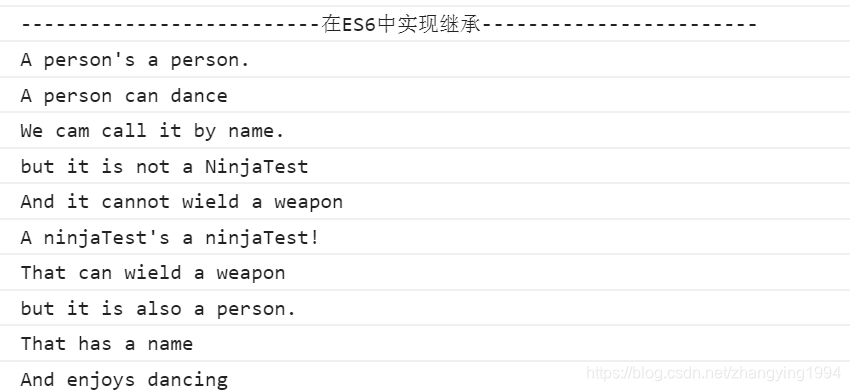实现继承
1.ES6之前的版本重中实现继承是一件痛苦个事。如下面代码:
function Person() {}
Person.prototype.dance = function(){};
function NinjaTest() {}
NinjaTest.prototype = new Person();
Object.defineProperty(NinjaTest.prototype, "constructor",{
enumerable: false,
value:NinjaTest,
writable:true
});
这里需要记住几点:对所有实例均可访问的方法必须直接添加在构造函数的原型上。如Person构造函数上的dance方法。为了实现继承,我们必须将实例对象衍生的原型设置成“基类”。在上面的代码中,我们将一个新的Person实例对象赋值NinjaTest.prototype。糟糕的是,这回弄乱constructor属性,所以需要通过Object.defineProperty方法进行手动投置。
console.log("--------------------------在ES6中实现继承------------------------");
class Person{
constructor(name) {
this.name = name;
}
dance() {
return true;
}
}
//使用关键字‘extends’实现继承
class NinjaTest extends Person {
constructor(name, weapon) {
//使用关键字'super'调用基类构造函数
super(name);
this.weapon = weapon;
}
wieldWeapon() {
return true;
}
}
var person = new Person("Bob");
if (person instanceof Person) {
console.log("A person's a person.");
}
if (person.dance()) {
console.log("A person can dance");
}
if (person.name === 'Bob') {
console.log("We cam call it by name.");
}
if (!(person instanceof NinjaTest)) {
console.log("but it is not a NinjaTest");
}
if(!("wieldWeapon" in person)) {
console.log("And it cannot wield a weapon");
}
var ninjaTest = new NinjaTest("Yoshi", "Wakizashi");
if (ninjaTest instanceof NinjaTest) {
console.log("A ninjaTest's a ninjaTest!");
}
if (ninjaTest.wieldWeapon()) {
console.log("That can wield a weapon");
}
if (ninjaTest instanceof Person) {
console.log("but it is also a person.");
}
if (ninjaTest.name === 'Yoshi') {
console.log("That has a name");
}
if (ninjaTest.dance()) {
console.log("And enjoys dancing");
}

上述代码中展示了ES6中的继承。使用extends从一个类实现继承:
class NinjaTest extends Person
在上面的代码中,创建Person类,其构造函数对每一个实例对象添加name属性。同时,定义一个所有Person的实例均可访问的dance方法。
class Person{
constructor(name) {
this.name = name;
}
dance() {
return true;
}
}
接着,我们定义一个从Person类继承而来的NinjaTest类。在NinjaTest类上添加weapon属性和wieldWeapon方法:
//使用关键字‘extends’实现继承
class NinjaTest extends Person {
constructor(name, weapon) {
//使用关键字'super'调用基类构造函数
super(name);
this.weapon = weapon;
}
wieldWeapon() {
return true;
}
}
衍生类NinjaTest构造函数通过关键字super调用基类Person的构造函数。这与其他基于类的语言是类似的。
创建Person实例,并验证Person类的实例具有name属性和dance方法,但不具有wieldWeapon方法:
var person = new Person("Bob");
if (person instanceof Person) {
console.log("A person's a person.");
}
if (person.dance()) {
console.log("A person can dance");
}
if (person.name === 'Bob') {
console.log("We cam call it by name.");
}
if (!(person instanceof NinjaTest)) {
console.log("but it is not a NinjaTest");
}
if(!("wieldWeapon" in person)) {
console.log("And it cannot wield a weapon");
}
创建一个ninjaTest实例,并验证ninja是类NinjaTest的实例,具有weaponWield方法。由于所有的ninjaTest同时也是类Person的实例,因此,因此,ninjaTest实例也具有name属性和dance方法:
var ninjaTest = new NinjaTest("Yoshi", "Wakizashi");
if (ninjaTest instanceof NinjaTest) {
console.log("A ninjaTest's a ninjaTest!");
}
if (ninjaTest.wieldWeapon()) {
console.log("That can wield a weapon");
}
if (ninjaTest instanceof Person) {
console.log("but it is also a person.");
}
if (ninjaTest.name === 'Yoshi') {
console.log("That has a name");
}
if (ninjaTest.dance()) {
console.log("And enjoys dancing");
}
从上面可知:定义类,通过关键字extends定义类之间的关系。
参考《JavaScript忍者秘籍》








 本文详细介绍了在ES6中如何使用类和继承特性来简化JavaScript的面向对象编程。通过对比ES6之前复杂的继承实现方式,展示了使用class和extends关键字进行类定义和继承的简洁性和有效性。
本文详细介绍了在ES6中如何使用类和继承特性来简化JavaScript的面向对象编程。通过对比ES6之前复杂的继承实现方式,展示了使用class和extends关键字进行类定义和继承的简洁性和有效性。
















 2688
2688

 被折叠的 条评论
为什么被折叠?
被折叠的 条评论
为什么被折叠?








